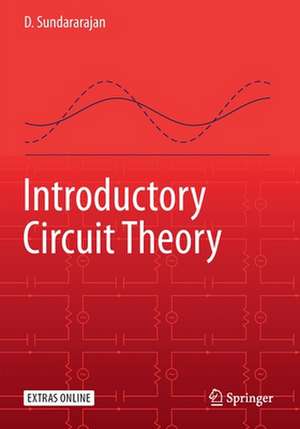Introductory Circuit Theory
Autor D. Sundararajanen Limba Engleză Paperback – 12 dec 2020
Written to be accessible to students of varying backgrounds, this textbook presents the analysis of realistic, working circuits
Presents concepts in a clear, concise and comprehensive manner, such as the difficult problem of setting up the equilibrium equations of circuits using a systematic approach in a few distinct steps
Includes worked examples of functioning circuits, throughout every chapter, with an emphasis on real applications Includes numerous exercises at the end of each chapter
Provides program scripts and circuit simulations, using the popular and widely used Matlab software, as supplementary material online
| Toate formatele și edițiile | Preț | Express |
|---|---|---|
| Paperback (1) | 393.52 lei 6-8 săpt. | |
| Springer International Publishing – 12 dec 2020 | 393.52 lei 6-8 săpt. | |
| Hardback (1) | 483.29 lei 6-8 săpt. | |
| Springer International Publishing – 5 dec 2019 | 483.29 lei 6-8 săpt. |
Preț: 393.52 lei
Nou
Puncte Express: 590
Preț estimativ în valută:
75.31€ • 78.18$ • 62.80£
75.31€ • 78.18$ • 62.80£
Carte tipărită la comandă
Livrare economică 22 martie-05 aprilie
Preluare comenzi: 021 569.72.76
Specificații
ISBN-13: 9783030319878
ISBN-10: 3030319873
Pagini: 297
Ilustrații: XI, 297 p. 243 illus.
Dimensiuni: 178 x 254 mm
Greutate: 0.54 kg
Ediția:1st ed. 2020
Editura: Springer International Publishing
Colecția Springer
Locul publicării:Cham, Switzerland
ISBN-10: 3030319873
Pagini: 297
Ilustrații: XI, 297 p. 243 illus.
Dimensiuni: 178 x 254 mm
Greutate: 0.54 kg
Ediția:1st ed. 2020
Editura: Springer International Publishing
Colecția Springer
Locul publicării:Cham, Switzerland
Cuprins
Basic Concepts.- DC Circuits.- AC Circuits.- Steady State Power.- Magnetically Coupled Circuits.- Three-phase Circuits.- Two-port Networks.- Transform Analysis and Transient Response.- Appendices.- Bibliography.- Answers to Selected Exercises.- Index.
Notă biografică
Dr. D. Sundararajan was formerly associated with Concordia University, Montreal, Canada. He holds a Ph.D degree in Electrical Engineering from Concordia University. As the principal inventor of the latest family of DFT algorithms, he holds U.S, Canadian and British patents. He has published six books. He has long experience in teaching and research. He has written several papers in IEEE transactions and IEEE conferences.
Textul de pe ultima copertă
This textbook for a one-semester course in Electrical Circuit Theory is written to be concise, understandable, and applicable. Matlab is used throughout, for coding the programs and simulation of the circuits. Every new concept is illustrated with numerous examples and figures, in order to facilitate learning. The simple and clear style of presentation, along with comprehensive coverage, enables students to gain a solid foundation in the subject, along with the ability to apply techniques to real circuit analysis.
· Written to be accessible to students of varying backgrounds, this textbook presents the analysis of realistic, working circuits;
· Presents concepts in a clear, concise and comprehensive manner, such as the difficult problem of setting up the equilibrium equations of circuits using a
systematic approach in a few distinct steps;
· Includes worked examples of functioning circuits, throughout every chapter, with an emphasis on real applications;
· Includes numerous exercises at the end of each chapter;
· Provides program scripts and circuit simulations, using the popular and widely used Matlab software, as supplementary material online.
· Written to be accessible to students of varying backgrounds, this textbook presents the analysis of realistic, working circuits;
· Presents concepts in a clear, concise and comprehensive manner, such as the difficult problem of setting up the equilibrium equations of circuits using a
systematic approach in a few distinct steps;
· Includes worked examples of functioning circuits, throughout every chapter, with an emphasis on real applications;
· Includes numerous exercises at the end of each chapter;
· Provides program scripts and circuit simulations, using the popular and widely used Matlab software, as supplementary material online.
Caracteristici
Written to be accessible to students of varying backgrounds, this textbook presents the analysis of realistic, working circuits Presents concepts in a clear, concise and comprehensive manner, such as the difficult problem of setting up the equilibrium equations of circuits using a systematic approach in a few distinct steps Includes worked examples of functioning circuits, throughout every chapter, with an emphasis on real applications Includes numerous exercises at the end of each chapter Provides program scripts and circuit simulations, using the popular and widely used Matlab software, as supplementary material online Includes supplementary material: sn.pub/extras Request lecturer material: sn.pub/lecturer-material
